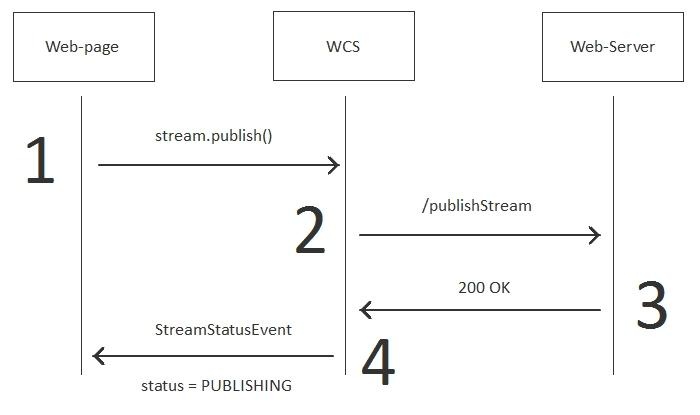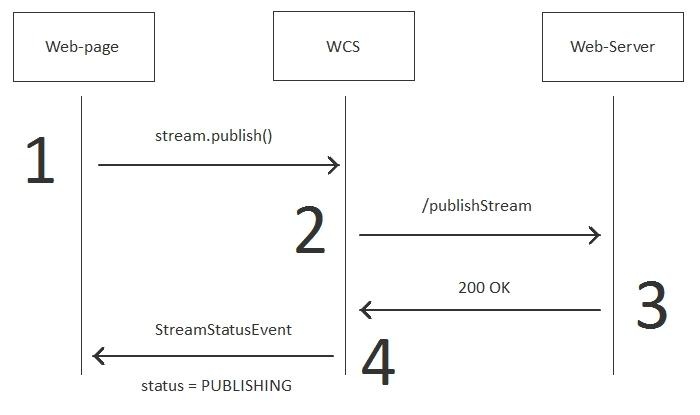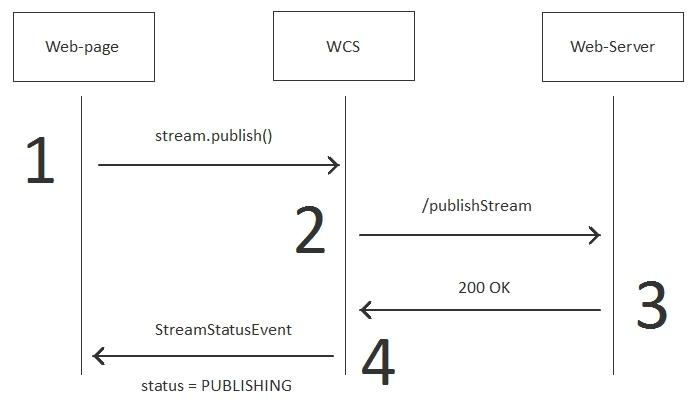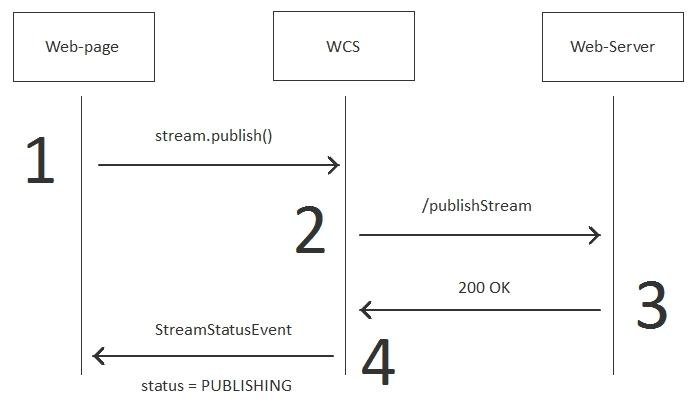Scheme of work on example of publishStream method
The publishStream REST method is a direct invoke method, because a client invokes this method with the stream.publish() command attempting to publish a video stream from the web camera. This operation can be authorized – cancelled or permitted – and parameters of this operation can be redefined on the side of the web server. For example, the field name=’stream1’ may be changed to name=’stream2’, and if such a replace succeeds, WCS will publish the stream with the new name stream2.
We have already described the publishStream method above, so here we simply cite the invocation sequence again:
Example:
2 | 3 |
|---|---|
POST /rest/my_api/publishStream HTTP/1.1
Accept: application/json, application/*+json
Content-Type: application/json;charset=UTF-8
User-Agent: Java/1.8.0_111
Host: 192.168.1.101
Connection: keep-alive
Content-Length: 3611
{
"nodeId":"Hw47CFMBEchVOpBMDr29IxjudnJ1sjOY@192.168.1.101",
"appKey":"defaultApp",
"sessionId":"/192.168.1.102:4388/192.168.1.101:8443",
"mediaSessionId":"56141d10-fddc-11e6-ac3a-4d67d5b3360d",
"name":"b4e7",
"published":true,
"hasVideo":true,
"hasAudio":true,
"status":"PENDING",
"sdp":".....",
"record":false,
"width":0,
"height":0,
"bitrate":0,
"quality":0,
"mediaProvider":"WebRTC"
}
| HTTP/1.1 200 OK
Date: Tue, 28 Feb 2017 17:35:43 GMT
Server: Apache/2.2.15 (CentOS)
X-Powered-By: PHP/5.3.3
Content-Length: 3653
Connection: close
Content-Type: application/json
{
"nodeId":"Hw47CFMBEchVOpBMDr29IxjudnJ1sjOY@192.168.1.101",
"appKey":"defaultApp",
"sessionId":"\/192.168.1.102:4388\/192.168.1.101:8443",
"mediaSessionId":"56141d10-fddc-11e6-ac3a-4d67d5b3360d",
"name":"b4e7",
"published":true,
"hasVideo":true,
"hasAudio":true,
"status":"PENDING",
"sdp":"",
"record":false,
"width":0,
"height":0,
"bitrate":0,
"quality":0,
"mediaProvider":"WebRTC"
}
|
Authentication
Authentication is similar to that of the connect method. You can send a token or a password here too, as well as permit / forbid the operation based on other parameters.
For authentication you need to configure the publishStream method at the connection stage (connect) and set restOnError:FAIL in the restClientConfig config.
Example:
2 | 3 |
|---|---|
POST /rest/my_api/publishStream HTTP/1.1
Accept: application/json, application/*+json
Content-Type: application/json;charset=UTF-8
User-Agent: Java/1.8.0_111
Host: 192.168.1.101
Connection: keep-alive
Content-Length: 3639
{
"nodeId":"Hw47CFMBEchVOpBMDr29IxjudnJ1sjOY@192.168.1.101",
"appKey":"defaultApp",
"sessionId":"/192.168.1.102:17749/192.168.1.101:8443",
"mediaSessionId":"0e17ab50-fdbc-11e6-8a47-c5292ef61cc0",
"name":"3a88",
"published":true,
"hasVideo":true,
"hasAudio":true,
"status":"PENDING",
"sdp":".....",
"record":false,
"width":0,
"height":0,
"bitrate":0,
"quality":0,
"mediaProvider":"WebRTC",
"custom":{
"token":"abcdef"
}
}
| HTTP/1.1 403 Forbidden Date: Tue, 28 Feb 2017 13:44:39 GMT Server: Apache/2.2.15 (CentOS) X-Powered-By: PHP/5.3.3 Content-Length: 0 Connection: close Content-Type: text/html; charset=UTF-8 |
Redefining fields
Redefining fields works when the method operates normally and the 200 OK response is returned. The purpose of redefining fields is, for instance, to hide the real name of the stream on the page from the end user.
For example, the user sends stream1, but the server changes the name to stream2.
To make such redefining, do the following:
- Enable "restPolicy":"OVERWRITE" in restClientConfig for the publishStream when connecting to the server.
- Put a comma-separated list of fields to overwrite in "restOverwrite":"". For example, "restOverwrite":"name" for restClientConfig. In this case, only the name field – the name of a stream – is overwritten.
- In the JSON body of the 200 OK response return the modified name field, and return other fields as they were received from the WCS server.
Example:
2 | 3 |
|---|---|
POST /rest/my_api/publishStream HTTP/1.1
Accept: application/json, application/*+json
Content-Type: application/json;charset=UTF-8
User-Agent: Java/1.8.0_111
Host: 192.168.1.101
Connection: keep-alive
Content-Length: 3612
{
"nodeId":"Hw47CFMBEchVOpBMDr29IxjudnJ1sjOY@192.168.1.101",
"appKey":"defaultApp",
"sessionId":"/192.168.1.102:12514/192.168.1.101:8443",
"mediaSessionId":"abbe7e90-fdcd-11e6-9831-bd76c6e822a1",
"name":"2a0c",
"published":true,
"hasVideo":true,
"hasAudio":true,
"status":"PENDING",
"sdp":".....",
"record":false,
"width":0,
"height":0,
"bitrate":0,
"quality":0,
"mediaProvider":"WebRTC"
}
| HTTP/1.1 200 OK
Date: Tue, 28 Feb 2017 15:50:44 GMT
Server: Apache/2.2.15 (CentOS)
X-Powered-By: PHP/5.3.3
Content-Length: 3669
Connection: close
Content-Type: application/json
{
"nodeId":"Hw47CFMBEchVOpBMDr29IxjudnJ1sjOY@192.168.1.101",
"appKey":"defaultApp",
"sessionId":"\/192.168.1.102:12514\/192.168.1.101:8443",
"mediaSessionId":"abbe7e90-fdcd-11e6-9831-bd76c6e822a1",
"name":"streamChangedName",
"published":true,
"hasVideo":true,
"hasAudio":true,
"status":"PENDING",
"sdp":".....",
"record":false,
"width":0,
"height":0,
"bitrate":0,
"quality":0,
"mediaProvider":"WebRTC"
}
|
Excluding fields from sending
This method works in one direction only, from WCS to the web server. This means you can exclude one or more fields that the WCS server sends to the web server in the JSON body of the response on step 2.
By default, publishStream sends all fields. To exclude field, put a comma-separated list of fields you want to exclude to the "restExclude":"" parameter in restClientConfigwhen establishing connection.
Operation example when the name field – the name of a stream – is excluded:
2 | 3 |
|---|---|
POST /rest/my_api/publishStream HTTP/1.1
Accept: application/json, application/*+json
Content-Type: application/json;charset=UTF-8
User-Agent: Java/1.8.0_111
Host: 192.168.1.101
Connection: keep-alive
Content-Length: 3602
{
"nodeId":"Hw47CFMBEchVOpBMDr29IxjudnJ1sjOY@192.168.1.101",
"appKey":"defaultApp",
"sessionId":"/192.168.1.102:9232/192.168.1.101:8443",
"mediaSessionId":"084db2f0-fdd5-11e6-9ba5-6ba06f30ad92",
"published":true,
"hasVideo":true,
"hasAudio":true,
"status":"PENDING",
"sdp":".....",
"record":false,
"width":0,
"height":0,
"bitrate":0,
"quality":0,
"mediaProvider":"WebRTC"
}
| HTTP/1.1 200 OK
Date: Tue, 28 Feb 2017 16:43:26 GMT
Server: Apache/2.2.15 (CentOS)
X-Powered-By: PHP/5.3.3
Content-Length: 3649
Connection: close
Content-Type: application/json
{
"nodeId":"Hw47CFMBEchVOpBMDr29IxjudnJ1sjOY@192.168.1.101",
"appKey":"defaultApp",
"sessionId":"\/192.168.1.102:9232\/192.168.1.101:8443",
"mediaSessionId":"084db2f0-fdd5-11e6-9ba5-6ba06f30ad92",
"published":true,
"hasVideo":true,
"hasAudio":true,
"status":"PENDING",
"sdp":".....",
"record":false,
"width":0,
"height":0,
"bitrate":0,
"quality":0,
"mediaProvider":"WebRTC"
}
|
Parsing stream URL parameters
When RTMP stream is published or played on WCS, RTMP connection and stream parameters may be set in stream URL like this:
rtmp://host:1935/live?connectParam1=val1&connectParam2=val2/streamName?streamParam1=val1&streamParam2=val2
Where
- host is WCS server hostname;
- connectParam1, connectParam2 are RTMP connection parameters;
- streamName is stream name on server;
- streamParam1, streamParam2 are stteam parameters.
WCS server passes the parameters to backend server in REST hook in custom field, for example:
| Connection parameters |
|---|
URL:http://localhost:8081/apps/EchoApp/connect
OBJECT:
{
"nodeId" : "Qb3rAjf3lzoy6PEl1WZkUhRG1DsTykgj@192.168.1.1",
"appKey" : "flashStreamingApp",
"sessionId" : "/127.0.0.1:5643/192.168.1.1:1935",
"useWsTunnel" : false,
"useWsTunnelPacketization2" : false,
"useBase64BinaryEncoding" : false,
"keepAlive" : false,
"custom" : {
"connectParam1" : "val1",
"connectParam2" : "val2"
},
"login" : "rQq83sodiCPY0pJXCxGO"
}
|
| Publishing parameters |
URL:http://localhost:8081/apps/EchoApp/publishStream
OBJECT:
{
"nodeId" : "Qb3rAjf3lzoy6PEl1WZkUhRG1DsTykgj@192.168.1.1",
"appKey" : "flashStreamingApp",
"sessionId" : "/127.0.0.1:5643/192.168.1.1:1935",
"mediaSessionId" : "627990f9-8fe5-4e92-bb2a-863cc4eb43de",
"name" : "stream1",
"published" : true,
"hasVideo" : false,
"hasAudio" : true,
"status" : "NEW",
"record" : true,
"width" : 0,
"height" : 0,
"bitrate" : 0,
"minBitrate" : 0,
"maxBitrate" : 0,
"quality" : 0,
"mediaProvider" : "Flash",
"custom" : {
"streamParam1" : "val1",
"streamParam2" : "val2"
}
}
|
| Playback parameters |
URL:http://localhost:8081/apps/EchoApp/playStream
OBJECT:
{
"nodeId" : "Qb3rAjf3lzoy6PEl1WZkUhRG1DsTykgj@192.168.1.1",
"appKey" : "flashStreamingApp",
"sessionId" : "/127.0.0.1:5643/192.168.1.1:1935",
"mediaSessionId" : "stream1/127.0.0.1:5643/192.168.1.1:1935",
"name" : "stream1",
"published" : false,
"hasVideo" : true,
"hasAudio" : true,
"status" : "NEW",
"record" : false,
"width" : 0,
"height" : 0,
"bitrate" : 0,
"minBitrate" : 0,
"maxBitrate" : 0,
"quality" : 0,
"mediaProvider" : "Flash",
"custom" : {
"streamParam1" : "val1",
"streamParam2" : "val2"
}
}
|
This feature can be used for example to authenticate client on backend server while publishing or playing RTMP-stream on WCS server.
playHLS and playRTSP methods
playHLS and playRTSP methods are intended for stream playback authentication via HLS and RTSP, accordingly. These methods are called without firts calling of /connect method, so it is impossible to change error handling policy and other parameters vis restClientConfig , the next policy is always used:
"restOnError":"FAIL"



